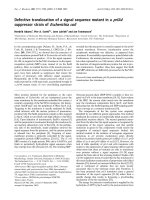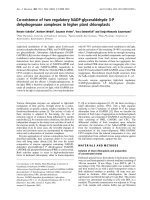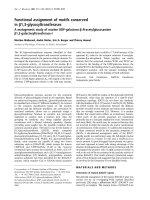Báo cáo y học: " Prompt improvement of a pressure ulcer by the administration of high viscosity semi-solid nutrition via a nasogastric tube in a man with tuberculosis: a case report" pdf
Bạn đang xem bản rút gọn của tài liệu. Xem và tải ngay bản đầy đủ của tài liệu tại đây (456.78 KB, 4 trang )
CAS E REP O R T Open Access
Prompt improvement of a pressure ulcer by the
administration of high viscosity semi-solid
nutrition via a nasogastric tube in a man with
tuberculosis: a case report
Tamaki Nakayama, Seiji Hayashi
*
, Kyoichi Okishio, Tomoko Tomishiro, Kaori Hosogai, Yuki Ootsu, Yasushi Morioka,
Kazuyoshi Hatsuda, Eriko Naito, Mitsunori Sakatani
Abstract
Introduction: Semi-solid nutrition with high viscosity has the advantage of reducing gastroesophageal reflux and
diarrhea and shortens the duration of administration compared with liquid nutrition. This is the first report
describing the administration of semi-solid nutrition with high viscosity via a nasogastric tube, which achieved a
remarkable improvement in the patient’s nutritional state.
Case presentation: A 67-year-old man (mongoloid race, Japanese) with tuberculosis, a pressure ulcer and
malnutrition was admitted to our hospital. He also had right hemiplegia, dysphagia and aphasia as sequelae of a
cerebral hemorrhage. Before his admission, he had been treated at another hospital with 600 kcal/day of liquid
nutrition via a nasogastric tube, which was insufficient and induced severe malnutrition. After he was admitted to
our hospital, we increased the quantity of his liquid nutrition without success because of complications, specifically
diarrhea and gastroesophageal reflux. As it was difficult to confirm whether or not he would accept gastrostomy
feeding, we administered semi-solid nutrition with high viscosity (20,000 mPa x s) via a large-bore nasogastric tube
(18 French). Soon after he was started on semi-solid nutrition, his pressure ulcer and malnutrition improved
without diarrhea or complications accompanying the large-bore nasogastric tube.
Conclusion: When patients have problems with liquid nutrition, such as diarrhea or gastroesophageal reflux, semi-
solid nutrition via a nasogastric tube is a useful method of achieving improvements in nutritional state in a short
period of time.
Introduction
Enteral nutrition has surpassed parenteral nutrition in
terms of safety and physiological benefits [1,2]. For a
patientwhohasproblemsswallowingbuthasanintact
intestinal tract, enteral nut rition is primarily recom-
mended [1]. Semi-solid enteral nutrition has the advan-
tage of lowering the risk of diarrhea and esophageal
reflux [3]. Here we report a case in which malnutrition,
diarrhea and a pressure ulcer were improved by high
viscosity semi-solid nutrition via a large-bore nasogastric
tube.
Case presentation
A 67-year-old man (mongoloid race, Japanese) was
admitted to our hospital because of a 3-day history of
fever. Acid-fast bacilli was found to be smear-positive in
his sputum, and a chest radiograph and computed
tomography examinations showed parenchymal opacities
with scattered fine nodules in his right apical region. He
was diagnosed with pulmonary tuberculosis, so he was
started on anti-tuberculosis therapy with isoniazid,
rifampicin, ethambutol, and pyrazinamide on the f irst
daythathewashospitalized.Hehaddevelopedacere-
bral hemorrhage 18 months before this hospitalization,
and he had right hemiplegia, dysphagia, and aphasia as
sequelae. He had been receiving 600 kc al/day of liquid
* Correspondence:
National Hospital Organization Kinki-Chuo Chest Medical Center, Nagasone-
Cho, Kita-Ku, Sakai-City, Osaka, 591-8555, Japan
Nakayama et al. Journal of Medical Case Reports 2010, 4:24
/>JOURNAL OF MEDICAL
CASE REPORTS
© 2010 Nakayama et al; licensee BioMed Central Ltd. This is an Open Access article distributed under the terms of the Creative
Commons Attribution License ( icenses/by/2.0), which permits unrestricted use, distribution, and
reproduction in any medium, provided the original work is properly cited.
nutritio n via a nasogastr ic tube for 6 months before the
current hospitalization.
On admission to our hospital, he had a 16.5 cm × 15.5
cm, grade IV [4] pressure ulcer in the sacral region,
from which Escherichia coli and methicillin-resistant
Staphylococcus were detected (Figure 1, panel A). His
albumin count was 2.2 g/dL, hemoglobin was 11.1 g/dL,
C-reactive protein was 12.0 mg/dL (Figure 2) and his
body temperature was 38°C. A liquid nutrition of 200
kcal was administered for 60 minutes, 3 times a day,
and this regimen was continued for 2 weeks. In order to
improvehisstateofnutritionandtoreduceweight-
bearing on the sacral region, 1,200 kcal/day of liquid
nutrition was administered for a shorter time. This,
however, induced watery diarrhea and gastroesophageal
reflux. His general condition and malnutrition (low
serum albumin) suggested that he would have a poor
prognosis if a gastrostomy was performed [5]. It was dif-
ficult to confirm whether or not he would accept gastro-
stomy feeding, so nasogastric tube feeding was
continued. As for the preparation, we selected semi-
solid nutrition with higher viscosity (20,000 mPa × s). In
order to achieve the administration in a certain short
period of time, a nasogastric tube o f 18 French was
inserted.
As the patient was febrile and bedridden, his total
energy expenditure was assessed as 1,708 kcal/day by
the Harris-Benedict equation [6] (presumed height 162
cm, presumed body weight 45 kg, ideal body weight
57.7 kg, activity factor = 1.1, stress factor = 1.5). Consid-
ering that his caloric prescription up to that time had
been 600 kcal/day and he had diarrhea, we first tried
1,200 kcal/day.
On day 21 in hospital, a semi-solid enteral product of
400 kcal/267 g ( PG Soft™,Terumo,Tokyo,Japan)was
administered for 15 minutes 3 times a day, which was
then followed by 250 mL of semi-solidified water (PG
Water™, Terumo, Tokyo, Japan) and dietary fiber. After
starting the semi-solid enteral product, he experienced
no diarrhea or esophageal reflu x. On day 22, a debride-
ment of the sacral pressure ulcer was conducted. Four
weeks later, an improvement was observed in his albu-
min, hemoglobin, an d C-reactive protein levels (Figure
2). His pressure ulcer was then 8.0 cm × 5.0 cm (Figure
1, panel D).
No complication of the esophagus, paranasal sinus, or
nose wings accompanying insertion of the nasogastric
tube was observed. Compliance of the large-bore naso-
gastri c tube was favorable, and he did not try to remove
the tube himself. With continuous maintenance of the
tube, no obstruction was observed. Administration of
anti-tuberculosisdrugswascontinuedviathenasogas-
tric tube without any adverse effects, and tubercle bacil-
lus was not detected in his sputa. After 3.5 months, he
Figure 1 Chronological change of pressure ulcer. (A) Day 0. The patient had a 16.5 cm × 15.5 cm, grade IV pressure ulcer in the sacral
region. (B) Day 22. Debridement was conducted. (C) Day 66. The pressure ulcer had shrunk along with an improvement in the patient’s state of
nutrition. (D) Day 93. The size of the pressure ulcer was 8.0 cm × 5.0 cm.
Nakayama et al. Journal of Medical Case Reports 2010, 4:24
/>Page 2 of 4
was transferred to another facility for further
recuperation.
Discussion
Our case report showed that nutrition improvement and
curative effects were obtained by nutrition with a higher
viscosity of about 20,000 mPa × s. In recent years, the
advantages of semi-solid nutrition over liquid nutrition
have been reported [3]. Liquid nutrition may not be the
best choice when it is needed to shorten the administra-
tion time and at the same time provide a sufficient
amount of calories. A small-bore nasogastric tube is
thus recommended from a viewpoint of compliance.
However, in this case, liquid nutrition was not appropri-
ate, and so we had no choice but to use a large-bore
nasogastric tube.
Due to its higher viscosity, semi-solid nutrition has
several advantages. One advantage is the reduction of
gastroesophageal reflux with the resultant prevention of
aspirat ion pneumonia [3]. The rate of proximal stomach
emptying contributes to the number of reflux episodes
per hour [7]. Nutrition with higher viscosity promotes
the passage of gastric content to the intestinal tract,
which shortens the gastric retention time [3,8]. Another
advantage is the prevention or improvement of diarrhea.
We used sem i-solid nutrition for patients with intract-
able diarrhea who had been administered with liquid
nutrition. Improvement of diarrhea was observed in 9
out of 14, or 64.2% o f patients (unpublished data). The
third advantage is that semi-solid nutrition can shorten
the duration of administration. The bolus administration
of liquid nutrition induces gastroesophageal reflux.
Hence, in order to prevent the reflux, continuous
administration is required [9]. The manufacturer of the
nutrition we used for this patient recommends that the
administration of the semi-solid nutrition be done in 15
minutes. Administration should be carried out in a sit-
ting position to minimize gastroesophageal reflux, but
this position may impose load to any pressure ulcer at
the sacral region.
In order to administer semi-solid nutrition in a short
time, we changed the size of our patient’s nasogastric
tube from small-bore to 18 French, and the pressure
ulcer that had existed for a long time disappeared in 3
months. As for amelioration of the pressure ulcer, the
favorable effects of debridement and the antibacterial
effect of anti-tuberculosis drugs must be taken into con-
sideration. Howev er, it is established that nutrition
improvement is indispensab le for the amelioration of a
pressure ulcer [10,11]. Hence, we believe that shortening
the administration time of nutrition largely contributed
to the improvement of our patient’s pressure ulcer.
It is not recommended to administer semi-solid nutri-
tion through a thinner tube with high pressure because
the liquid spouting from the tip may injure the gastric
mucosa. When semi-solid nutrition is given via a naso-
gastric tube, there is a risk for tube obstruction, but we
avoided this by using a large-bore tube.
Conclusions
When patients have problems with liquid nutrition, such
as diarrhea or gastroesophageal reflux, semi-solid nutri-
tion via a nasogastric tube is a useful method for
improving nutrition in a short period of time.
Consent
Written informed consent was obtained from the patient
for publication of this case report and any
Figure 2 Chronological change of hemoglobin concentration (square), serum albumin concentration (circle) and C-reactive protein
titer (triangle). Anti-tuberculosis drugs were started on the first day of admission (arrow a). Liquid nutrition was increased to 1,200 kcal/day on
the 14
th
day of admission (arrow b). Semi-solid nutrition of 1,200 kcal/day was started on the 21
st
day of admission (arrow c). Debridement of
the sacral pressure ulcer was conducted on the 22
nd
day of admission (arrow d).
Nakayama et al. Journal of Medical Case Reports 2010, 4:24
/>Page 3 of 4
accompanying images. A copy of the written consent is
available for review by t he Editor-in-Chief of this
journal.
Acknowledgements
This study was supported by a grant-in-aid from the Osaka Tuberculosis
Foundation. The authors are grateful to Ms. Reiko Hayashi for her linguistic
help.
Authors’ contributions
TN, KH, YO and YM performed the assessment of the nutrition state and
designed the nutrition treatment plan of the patient. SH supervised the
nutrition treatment plan, wrote the manuscript, and reviewed the
international literature. KO, TT and EN treated the patient’s tuberculosis and
pressure ulcer. KH participated in the assessment of the patient’s clinical
data. MS supervised the treatment of tuberculosis and revised the
manuscript for important intellectual content. All authors read and approved
the final manuscript.
Competing interests
The authors declare that they have no competing interests.
Received: 22 November 2008
Accepted: 27 January 2010 Published: 27 January 2010
References
1. Kochevar M, Guenter P, Holcombe B, Malone A, Mirtallo J: ASPEN
statement on parenteral nutrition standardization. JPEN J Parenter Enteral
Nutr 2007, 31(5):441-448.
2. Levine GM, Deren JJ, Steiger E, Zinno R: Role of oral intake in
maintenance of gut mass and disaccharide activity. Gastroenterol 1974,
67(5):975-982.
3. Kanie J, Suzuki Y, Iguchi A, Akatsu H, Yamamoto T, Shimokata H: Prevention
of gastroesophageal reflux using a n application of half-solid nutrients in
patients with percutaneous endoscopic gastrostomy feeding. JAm
Geriatr Soc 2004, 52(3):466-467.
4. Pressure ulcer stages. />5. Lang A, Bardan E, Chowers Y, Sakhnini E, Fidder HH, Bar-Meir S, Avidan B:
Risk factors for mortality in patients undergoing percutaneous
endoscopic gastrostomy. Endosc 2004, 36(6):522-526.
6. Harris JA, Benedict FG: A biometric study of human basal metabolism.
Proc Natl Acad Sci (USA) 1918, 4(12):370-373.
7. Stacher G, Lenglinger J, Bergmann H, Schneider C, Hoffmann M, Wölfl G,
Stacher-Janotta G: Gastric emptying: a contributory factor in gastro-
oesophageal reflux activity?. Gut 2000, 47(5):661-666.
8. Andres JM, Mathias JR, Clench MH, Davis RH: Gastric emptying in infants
with gastroesophageal reflux: measurement with a technetium-99m-
labeled semisolid meal. Dig Dis Sci 1988, 33(4):393-399.
9. Coben RM, Weintraub A, DiMarino AJ Jr, Cohen S: Gastroesophageal reflux
during gastrostomy feeding. Gastroenterol 1994, 106(1):13-18.
10. Ayello EA, Thomas DR, Litchford MA: Nutritional aspects of wound
healing. Home Healthc Nurse 1999, 17(11):719-729.
11. Pinchcofsky-Devin GD, Kaminski MV Jr: Correlation of pressure sores and
nutritional status. J Am Geriatr Soc 1986, 34(6):435-440.
doi:10.1186/1752-1947-4-24
Cite this article as: Nakayama et al.: Prompt improvement of a pressure
ulcer by the administration of high viscosity semi-solid nutrition via a
nasogastric tube in a man with tuberculosis: a case report. Journal of
Medical Case Reports 2010 4:24.
Submit your next manuscript to BioMed Central
and take full advantage of:
• Convenient online submission
• Thorough peer review
• No space constraints or color figure charges
• Immediate publication on acceptance
• Inclusion in PubMed, CAS, Scopus and Google Scholar
• Research which is freely available for redistribution
Submit your manuscript at
www.biomedcentral.com/submit
Nakayama et al. Journal of Medical Case Reports 2010, 4:24
/>Page 4 of 4









